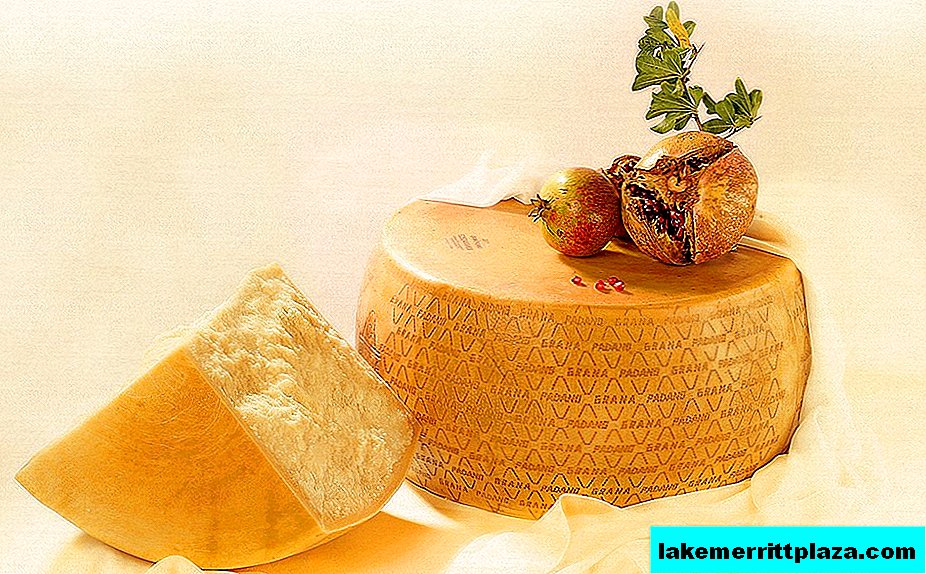He knows how hard it is to live in the shadow of a famous relative Grana Padano (Grana Padano) - hard Italian cheese and part-time younger brother of Parmigiano Reggiano. Many people often confuse it with parmesan, some believe that it is a low-quality analogue, and someone has never heard of it at all. Yes, not a king, but still this cheese deserves attention!

How was born and lived
The story goes that Grana Padano was born in the countryside by the Po River around 1000. There wasn’t such an abundance of food at that time as it is today. Not a single product obtained on the farm wasted. In connection with the development of animal husbandry, the question arose about the use of milk not used during the day. Fresh cheese quickly deteriorated, so the idea came up of hard cheese, which later gained great popularity.
It is believed that the mass production of grains began in 1135 on the monastery territory in Chiaravalle Abbey. Therefore, monasteries can rightfully be considered the first large-scale cheese dairies.
The monks called this cheese caseus vetus, which means "old cheese". But most ordinary consumers did not know Latin and came up with a different name for it, indicating its grainy texture (grana - grain). So the cheese received a new name "Formaggio di Grana" or simply "Grana", which has survived to this day.
There is evidence that the oldest grana Padano is from Lodi, but along with it are mentioned Milan (Milano), Parma (Parma), Piacenza (Piacenza), Mantova (Mantova).
Over time, this product began to be considered very valuable, and therefore its popularity was growing rapidly. So, for example, there is a record of how, in 1504, Isabella d'Este, sharing it with her father and brother (Lords of Ferrara), said: "Half of the cheese for each of you, because its value is more important than its quantity!"
Grana was in demand to such an extent that in 1525 the overseer of one of the farms complained about how difficult it is to get the “eight slices of a good three-year-old cheese” that the king of Spain promised.
The next three centuries did not make any changes to the technology of its manufacture. Only after 1837 were the first cheese-making research institutes created. Global changes in production occurred on June 1, 1951, when an agreement was signed establishing clear production rules and quality characteristics of cheese.

After that two separate varieties of Grana Lodigiano (Grana Lodigiano) appeared, which later became Grana Padano, and Parmigiano Reggiano (Parmigiano-Reggiano). On October 30, 1955, by decree of the president of the republic, "production methods, features and areas of cheese production" were defined.
In 1996, Grana Padano received the status of cheese with a protected name by origin (DOP).
How do
The rules for making gran padano have not changed for almost a thousand years. It is made in many provinces of 5 regions of Italy: Emilia-Romagna, Lombardia, Piemonte, Trentino-Alto Adige, Veneto.
There are special requirements for milk for cheese, but it is worth noting that they are not as strict as for parmesan. In the diet of dairy cows, at least 75% of the feed must be received in the production area. For the production of grains, partially skim milk is taken from no more than 2 milks.
The cheese making process takes place in copper or inside copper-coated boilers, shaped like an inverted bell with a volume of 1000 liters. From one vat, in the end, two heads of cheese will be obtained, which the masters call "twins."
The milk is heated to 31-33 degrees, add starter serum remaining from the cheese of the previous day, and rennet obtained from calves, and left to clot for 45-60 minutes. Next, the cheese clot is cut and, stirring, continue heating to 53-56 degrees. Curd particles settle to the bottom of the boiler for about 70 minutes.
After that, the operators, using wooden shovels and a cloth called "schiavino" (translated from Italian means "slave"), lift the clot from the vat and divide it into two equal parts. Each half is wrapped in a linen towel.
The new cheese is placed in a wooden mold, Teflon is also used now, and firmly pressed with a heavy disk of the same material. After about 12 hours, plates marked with four-leaf clover, serial number, provincial code, month of production, and dotted rhombuses (gran padano symbol) are distributed across the surface between the cheese and the mold wall. Then add a layer of casein, which will become part of the cheese crust.
After 24 hours, the cheese is placed in a steel, perforated, slightly convex shape, which will give it the final look in a couple of days.
Now the grana is ready for salting, it is placed in salt water for 16-25 days (time depends on the size, shape and level of salting).After drying in special rooms, the ripening process begins, which lasts from 9 to 24 months. It takes place in rooms equipped with proper ventilation and temperature and humidity control systems. All this period the cheese is wiped and turned over every 15 days. Such operations, previously performed manually, are now fully robotic.

At the end of the whole process, the quality of the cheese is determined using special tools (a small hammer, needle and probe) in the presence of experts from the Consortium. Heads with the necessary parameters receive the Grana Padano stamp, without which the cheese is not considered genuine and cannot be sold under that name.
One cheese head must necessarily have a weight of 24 to 40 kg. About 15 liters of milk are consumed for the production of 1 kg of grains.
In the past, cheese was distinguished by quality depending on the season of manufacture:
- "Vernengo" - produced from December to March;
- "Di testa" - cooked from April to June (considered the best);
- "Tardivo o terzolo" - October-November product.
This separation was based on the quality of feed received by cows in different months. Now this difference has been overcome, since the animals mainly feed on homogeneous harvested hay. Thus, all year round we have uniformly quality Grana Padano.
How to eat and store it

Grana Padano is no doubt an honored guest on any table and in any form, whether it is grated flakes or slices the size of one bite, main dishes or even desserts. It has a spicy, moderately salty taste with pronounced nutty notes. It serves as a component of both traditional Italian dishes and recently invented recipes.
Cheese emphasizes the taste of any pasta dish, enhances the taste of meat in cold or hot form. Grated grana surprisingly transforms the aroma of baked fish or stewed vegetables.

On the shelves you can meet Grana Padano in 3 degrees of maturity:
- 9-16 months - the cheese has a granular texture, a pale milky color and a delicate taste. It goes well with chilled fruity white wines;
- 16 month cheese - the structure is more granular, the sweetness is less noticeable, the taste becomes sharper and more expressive. This option is suitable for young red wines with a long finish;
- More than 20 months or "Riserva" - A relatively young variety, designed for real gourmets. The consistency is very fragile, the color is pale yellow, the taste is as full as possible, tart, piquant. It is chosen as an aperitif for wines with a sweet, velvety taste, a large amount of tannins and a high alcohol content. For example, sweet dessert wines such as Passito. It goes well with any nuts and fruits (grapes, figs).
It will not be amiss to say that the grana padano will delightfully transform any dish in which hard cheese is needed. You can read about the difference between grano padano and parmesan in our article "Parmesan is the king of the cheese world."
Cheese "Lollipops" Recipe
We will share with you the recipe for an original treat. All that is needed is:
- Grana Padano 240 g;
- Peeled pistachios 70 g;
- Paprika 20 g;
- Peeled Pumpkin Seeds 70 g

Grate cheese, chop pistachios and pumpkin seeds. On the baking paper, form three flat circles (approximately 10 cm in diameter) from the cheese, sprinkle the remaining ingredients on top and bake in the microwave oven at maximum power for a minute, after putting a wooden skewer in the center of each circle. Let cool and serve unusual “lollipops” as an aperitif, while paying attention to the enthusiastic faces of the guests.
The best way to store Grana Padano is to keep the refrigerator as cold as possible. If you have not had time to use all the cheese, then you should put it in a vacuum container or wrap it tightly with cellophane to avoid contact with moist air.
In principle, its shelf life under the right conditions is unlimited, since, due to prolonged exposure, the moisture content in it is such that pathogenic bacteria have no opportunity for development.
Calorie content and benefits

Grana Padano has unique nutritional characteristics due to the use of natural, high-quality raw materials and a long ripening time. Calorie content 100 g cheese 384 kcalwhich contain:
- Proteins 33 g;
- Fats 28 g;
- Carbohydrates 0 g;
- Cholesterol 140 mg;
- Calcium 1165 mg;
- Phosphorus 692 mg;
- Sodium chloride 1.6 g;
- Potassium 120 mg;
- Magnesium 63 mg;
- Zinc 11 mg;
- Iron 140 mcg;
- Copper 500 mcg;
- Selenium 12 mcg;
- Iodine 35.5 mcg.

Due to the long maturation of the grains, padano is rich in modified proteins, which are easily digested and quickly absorbed. It also contains free amino acids that stimulate digestive enzyme activity. This fact makes cheese an indispensable product for athletes, children (as the first cheese feeding) and pregnant women.
The minerals included in its composition are very valuable for the health of bones, muscles, teeth, which is extremely necessary for people of age.
About 40% of the fat contained in cheese is unsaturated. These compounds support the health of the heart and blood vessels, participate in the synthesis of many hormones, provide protection against inflammatory processes, and are the foundation of a healthy skin and hair.
The calcium content of only 50 g of cheese is such that it covers 60% of the daily norm of an adult, 50% of the day-oldness of older people, 43% of day-olds of teenagers and pregnant women. This mineral plays an important role in the processes of muscle contraction, cell permeability from bone integrity.

In addition, grana padano gives the body:
- Phosphorus, responsible for dental health;
- Iodine, which is an important component of the normal functioning of the thyroid gland;
- Copper and zinc, preventing the aging of cells and maintaining muscle tone;
- Selenium, normalizing the functioning of the immune and cardiovascular system;
- Magnesium, catalyzing the work of certain enzymes that regulate metabolism;
- The cheese contains 8 vitamins (A, B1, B2, B6, B12, D, PP, E), the intake of which occurs only with foodth. This kit is responsible for the proper functioning of almost all human systems.
Due to its unique nutritional value, grana padano meets all the requirements of a balanced daily diet.
Price per kg in Russia and Italy

It is hardly possible for Russian consumers to find at least counterfeit grains of padano on the shelves. Going around local supermarkets, we met with Parmesatto, Parmesinho, Parmaggio and other variations on the theme of Parmesan, but not a single analogue of grains.
The Internet, on the contrary, is replete with offers of genuine Italian cheese of the DOP category at a price of 1700 to 3500 per kg (most online stores offer a cost in the region of 2200 rubles).
But of course, to taste the authentic Original Grana Padano, you just need to go to Italy. Despite the remarkable quality, its price is very different from the cost of parmesan. In Italian stores you can buy it for 6.5-17 Euros per kg, depending on age.
That is all you could learn about grana padano. We hope you noticed that, not being a king, he is as close as possible to his famous brother. Live with love, do not be afraid to try new things, travel with optimism and remember: "A penny saves a ruble, and Grana Padano - five hundred!"








